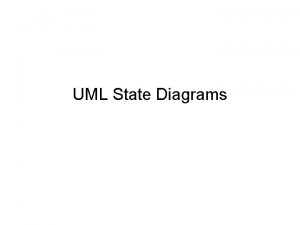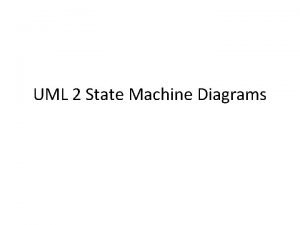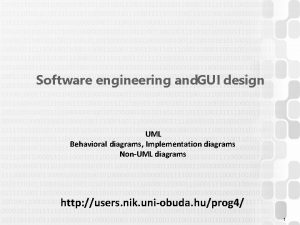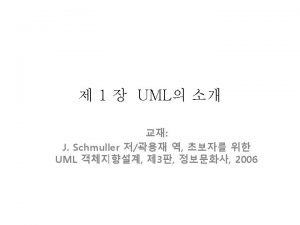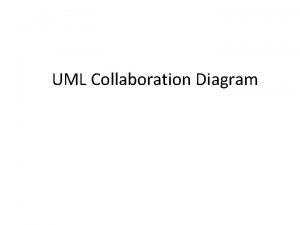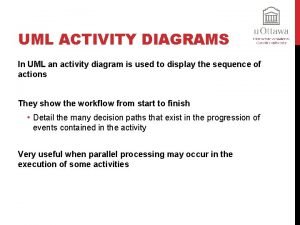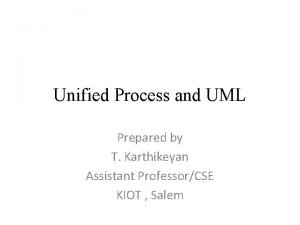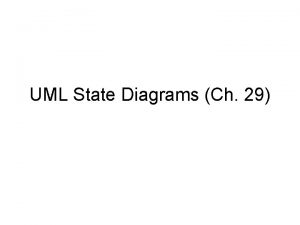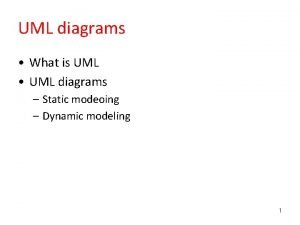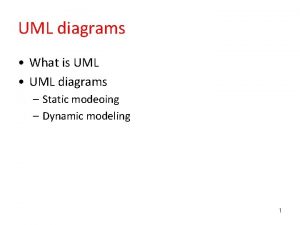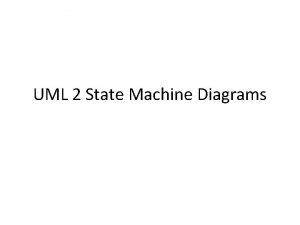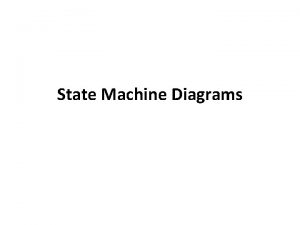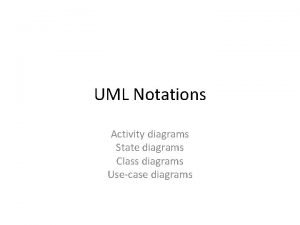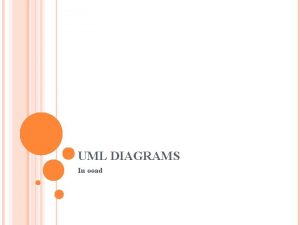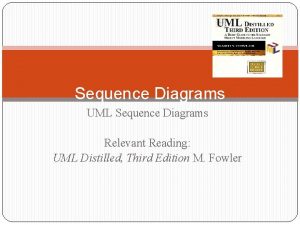UML 2 State Machine Diagrams State Machine Diagrams











- Slides: 11

UML 2 State Machine Diagrams

State Machine Diagrams • A state machine diagram models the behavior of a single object, specifying the sequence of events that an object goes through during its lifetime in response to events. As an example, the following state machine diagram shows the states that a door goes through during its lifetime. • • The door can be in one of three states: "Opened", "Closed" or "Locked". It can respond to the events Open, Close, Lock and Unlock. Notice that not all events are valid in all states; for example, if a door is opened, you cannot lock it until you close it. Also notice that a state transition can have a guard condition attached: if the door is Opened, it can only respond to the Close event if the condition door. Way->is. Empty is fulfilled. The syntax and conventions used in state machine diagrams will be discussed in full in the following sections.

State Machine Diagrams • States - A state is denoted by a round-cornered rectangle with the name of the state written inside it. • Initial and Final States - The initial state is denoted by a filled black circle and may be labeled with a name. The final state is denoted by a circle with a dot inside and may also be labeled with a name.

State Machine Diagrams • Transitions - Transitions from one state to the next are denoted by lines with arrowheads. A transition may have a trigger, a guard an effect, as below. • Self-Transitions - A state can have a transition that returns to itself, as in the following diagram. This is most useful when an effect is associated with the transition. • "Trigger" is the cause of the transition, which could be a signal, an event, a change in some condition, or the passage of time. "Guard" is a condition which must be true in order for the trigger to cause the transition. "Effect" is an action which will be invoked directly on the object that owns the state machine as a result of the transition.

State Machine Diagrams • State Actions - In the transition example above, an effect was associated with the transition. If the target state had many transitions arriving at it, and each transition had the same effect associated with it, it would be better to associate the effect with the target state rather than the transitions. This can be done by defining an entry action for the state. The diagram below shows a state with an entry action and an exit action. • It is also possible to define actions that occur on events, or actions that always occur. It is possible to define any number of actions of each type.

State Machine Diagrams • Compound States - A state machine diagram may include sub-machine diagrams, as in the example below. Alternative way to show the same information • The ∞ symbol indicates that details of the Check PIN sub-machine are shown in a separate diagram.

State Machine Diagrams • Entry Point - Sometimes you won’t want to enter a sub-machine at the normal initial state. For example, in the following sub-machine it would be normal to begin in the "Initializing" state, but if for some reason it wasn’t necessary to perform the initialization, it would be possible to begin in the "Ready" state by transitioning to the named entry point. • Exit Point - In a similar manner to entry points, it is possible to have named alternative exit points. The following diagram gives an example where the state executed after the main processing state depends on which route is used to transition out of the state.

State Machine Diagrams • Choice Pseudo-State - A choice pseudo-state is shown as a diamond with one transition arriving and two or more transitions leaving. The following diagram shows that whichever state is arrived at, after the choice pseudostate, is dependent on the message format selected during execution of the previous state.

State Machine Diagrams • Junction Pseudo-State - Junction pseudo-states are used to chain together multiple transitions. A single junction can have one or more incoming, and one or more outgoing, transitions; a guard can be applied to each transition. Junctions are semantic-free. A junction which splits an incoming transition into multiple outgoing transitions realizes a static conditional branch, as opposed to a choice pseudo-state which realizes a dynamic conditional branch.

State Machine Diagrams • Terminate Pseudo-State - Entering a terminate pseudo-state indicates that the lifeline of the state machine has ended. A terminate pseudo-state is notated as a cross. • History States - A history state is used to remember the previous state of a state machine when it was interrupted. The following diagram illustrates the use of history states. The example is a state machine belonging to a washing machine.

State Machine Diagrams • Concurrent Regions - A state may be divided into regions containing substates that exist and execute concurrently. The example below shows that within the state "Applying Brakes", the front and rear brakes will be operating simultaneously and independently. Notice the use of fork and join pseudo-states, rather than choice and merge pseudo-states. These symbols are used to synchronize the concurrent threads.
